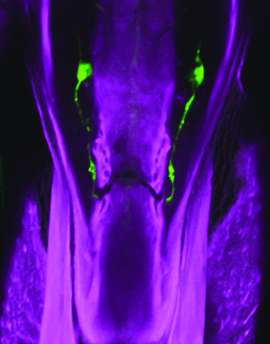Sugar-craving crushed—in flies, at least

Yale scientists have discovered ways to blunt the craving for sugar—in fruit flies, at least.
A single pair of neurons in the throat of Drosophila act as a brake on consumption of sucrose, according to a new study published in April in the journal eLife.
"This was very surprising because most sugar-sensing taste cells promote eating, but these are doing just the opposite," said John Carlson, the Eugene Higgins Professor of Molecular, Cellular & Developmental Biology and senior author of the study.
The control of fundamental processes such as eating, Carlson points out, is often very similar in Drosophila and humans, which are in the midst of a rapidly growing global obesity epidemic.
The Yale team—including first author Ryan M. Joseph, Jennifer S. Sun, and Edric Tam—investigated a Drosophila gene of unknown function. They found that the gene, IR60b, was expressed only in a single pair of nerve cells found in the pharynx of flies. When either this gene or these nerve cells were disabled, flies ate more sucrose. Alternately, when the nerve cells were activated by red light via optogenetics, the flies ate less.
Carlson noted that this genetic brake on sucrose consumption was slow to activate, suggesting that mechanisms to induce feeding are activated quickly and are then inhibited by IR60b.
The scientists now plan to see if mammals use the same system to control the amount of sugar they consume.
More information: Ryan M Joseph et al. A receptor and neuron that activate a circuit limiting sucrose consumption, eLife (2017). DOI: 10.7554/eLife.24992
Journal information: eLife
Provided by Yale University





















